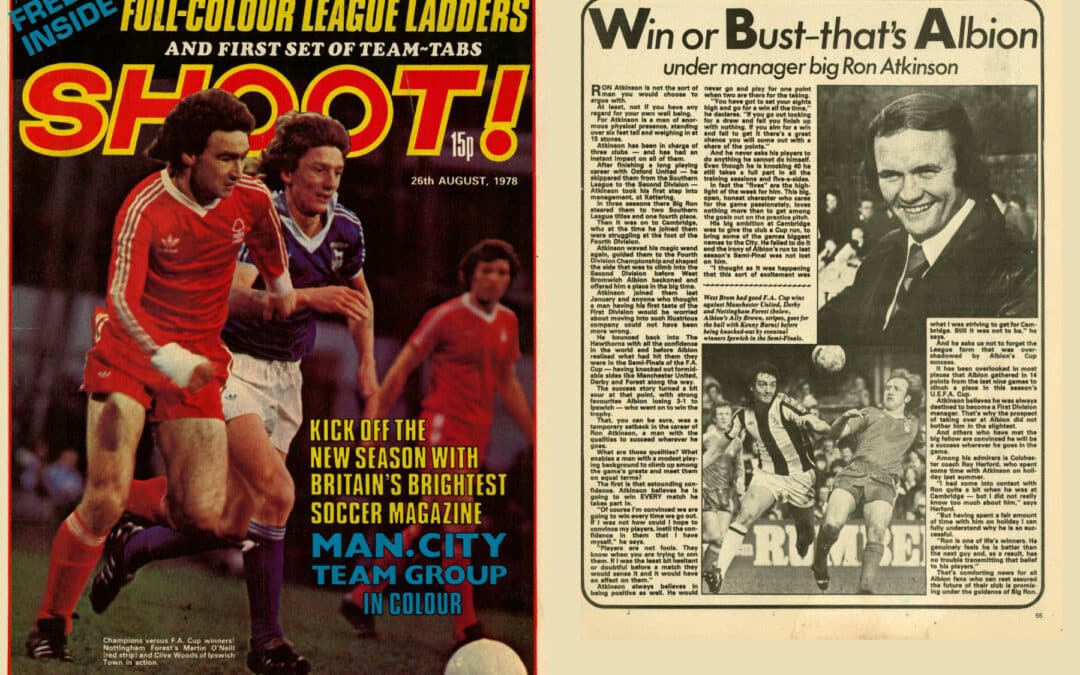August 26th 1978. Football fans across Britain eagerly anticipated the weekend fixtures, but one publication captured the essence of the beautiful game like no other. SHOOT Magazine’s latest issue hit the shelves featuring two of football’s brightest talents locked in sporting combat—a snapshot that would become emblematic of English football’s golden era.
The cover showcased Nottingham Forest’s Martin O’Neill squaring off against Ipswich Town’s Clive Woods, representing their respective clubs in what the magazine dubbed a battle between “Champions versus FA Cup Winners.” This wasn’t just another football photograph; it was a moment frozen in time that perfectly encapsulated the competitive spirit driving English football forward.
The Men Behind the Magic
Martin O’Neill, Forest’s tenacious midfielder, had become synonymous with Brian Clough’s revolutionary approach at the City Ground. His intelligent play and leadership qualities were already marking him as future management material—a prediction that would prove remarkably prescient in the decades to follow.
Meanwhile, Clive Woods represented Ipswich Town’s technical prowess under Bobby Robson’s guidance. The club’s FA Cup triumph had established them as genuine contenders, and Woods embodied their blend of skill and determination that made them such formidable opponents.
Big Ron’s Albion Revolution
Inside the magazine’s pages, another compelling story unfolded. West Bromwich Albion, under the charismatic leadership of Ron Atkinson, faced their own moment of truth. The headline “Win or Bust” perfectly captured the high-stakes atmosphere surrounding the Hawthorns.
Atkinson, known for his flamboyant style both on and off the pitch, had transformed Albion into an entertaining side that played football the right way. His philosophy of attacking play and tactical innovation was already making waves throughout the First Division, setting the stage for what would become a legendary managerial career.
SHOOT Magazine’s Cultural Impact
SHOOT Magazine occupied a unique position in British football culture. More than just match reports and league tables, it provided intimate access to the personalities shaping the game. The publication understood that football fans craved connection with their heroes, offering behind-the-scenes insights that television coverage simply couldn’t match.
The magazine’s approach to storytelling—combining action photography with compelling narratives—helped elevate football journalism beyond simple match reporting. Each issue became a collector’s item, preserving moments that would later be recognised as historically significant.
A Snapshot of Football’s Evolution
This particular issue represents more than nostalgic memorabilia; it captures English football at a crossroads. The late 1970s marked a period of tactical evolution, with managers like Clough, Robson, and Atkinson pioneering approaches that would influence the game for generations.
The players featured—O’Neill and Woods—would go on to leave lasting legacies, though in different ways. O’Neill’s transition to management saw him achieve remarkable success with Leicester City, Celtic, and later Aston Villa. Woods continued to be a reliable performer for club and country, representing the workmanlike dedication that characterised English football.
The Magic of Football Media
Looking back at this SHOOT Magazine cover reminds us of football media’s power to create lasting memories. Before social media and instant digital access, publications like SHOOT served as the primary connection between fans and their sporting heroes.
The magazine’s ability to capture defining moments—like O’Neill versus Woods—demonstrates how print media could elevate individual matches into cultural events. These weren’t just games; they were stories waiting to be told, personalities ready to be celebrated.
Preserving Football History
Today, as we scroll through endless digital content, there’s something deeply satisfying about holding a piece of football history. This SHOOT Magazine issue serves as a tangible reminder of when anticipation built slowly, when stories developed over weeks rather than minutes, and when football magazines were treasured possessions rather than disposable content.
The cover’s enduring appeal lies not just in the quality of the photography or the prominence of the featured players, but in its representation of football’s human element—the personal battles, individual brilliance, and collective dreams that make the sport eternally compelling.

